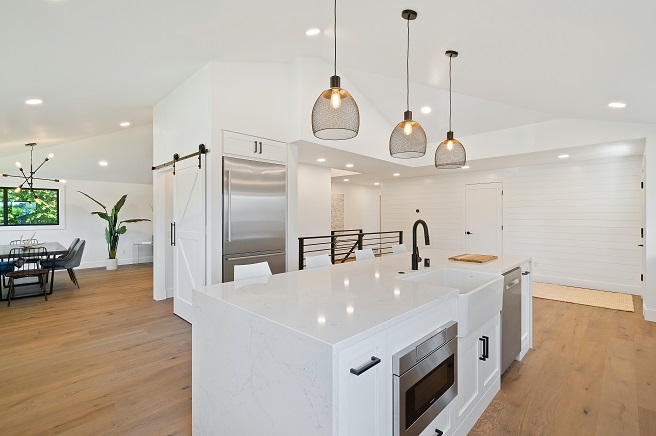Flat, eggshell, satin, gloss: When it comes to interior decor, there are a lot of confusing terms, but at least the names for paint finishes are fairly straightforward.
Even the most novice painter can guess what’s what.
Flat (or matte) is a smooth surface without luster. Eggshell resembles its namesake. Satin has a subtle sheen reminiscent of the popular fabric. And gloss is, well, glossy.
When shopping for paints you’re faced with the inevitable question: What finish? To sheen or not to sheen?
But there’s so much more behind choosing a paint finish than just their names.
Some finishes work better than others in high-traffic areas.
Some hide imperfections that are common in older buildings.
And others add extra pizazz for home decor projects.
The next time you’re choosing paint finishes, use this user-friendly paint-finish guide, with some expert input courtesy of international color expert and designer Maria Killam, to help you find your perfect paint.
1. Flat
The Basics:
Lacking any sheen whatsoever, flat paint is light-absorbing with a smooth finish.
The flat paint finish hides imperfections but also holds dirt and is difficult to clean.
Rubbing it with cleanser may even damage the finish.
Also known as Matte.
The Use:
Living rooms, dining rooms, bedrooms, hallways and ceilings.
“If you have walls with a lot of imperfections, flat hides them,” Killam says.
“And ceilings should be flat for that same reason.”
Good to Know:
It’s a good idea to keep extra paint on hand to touch up nicks and scratches in flat finishes.
2. Eggshell
The Basics:
This low-sheen paint finish resembles the shell of an egg, so no, the name is not a coincidence!
Eggshell paint absorbs light just like its flat counterpart above.
It’s best used in lower-traffic areas, and is easier to clean than flat.
Also known as Low-Luster
The Use:
Living rooms, dining rooms, kitchens, bedrooms, entryways, hallways and trims.
“I like walls to have a little shine, so I always specify eggshell for the main rooms in a house, hallways, living and family rooms,” Killam says.
3. Satin
The Basics:
A subtle finish with a soft sheen that reflects light.
This is one of the most versatile finishes as it falls in the middle of the spectrum.
It can be wiped clean with ease, making it ideal for active areas.
Also known as Pearl with certain paint brands.
The Use:
Kitchens, dining rooms, children’s bedrooms, guest or powder baths, laundry rooms, trims, doors and shutters.
“Satin is great for bathrooms and kitchens thanks to its high scrub-ability,” Killam says.
4. Semigloss
The Basics:
A step up in sheen from satin, semigloss paint finish reflects more light.
It can be scrubbed to keep clean, so it’s a great choice in areas with high traffic.
The Use:
Kitchens, bathrooms, hallways, cabinets, doors, trims and moldings.
“If you are using latex paint for trim and doors, a higher sheen will give you more durability,” Killam says.
5. Gloss
The Basics:
Gloss paint finishes come with a smooth, high-shine sheen. Opt for high-gloss paint for the light-reflecting extreme of paint finishes.
Gloss can be scrubbed clean without concern for the finish, so it’s ideal for areas that most often require washing.
The Use:
Kitchens, baths, trims, woodwork, moldings, doors and cabinets.
“If you opt to use a high-gloss finish to create an interesting sheen effect, such as on a ceiling or powder room,” Killam says, “spray it on to prevent roller or brush marks in the final finish.”

